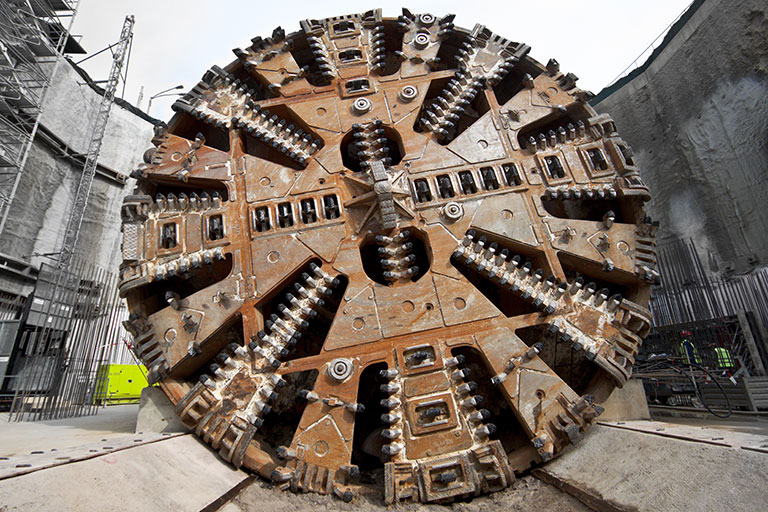Carving their way hundreds of metres below surface-level and through challenging conditions, tunnel boring machines (TBMs) have revolutionised underground infrastructure
With some measuring up to 60km long and as deep as 2.4km, tunnels represent some of the toughest engineering challenges in the world. Weaving through mountains and under rivers and seas, these huge projects are only made possible through steel-built equipment. It is steel that holds the strength and weight that the TBMs that create these underground roads and railways are reliant upon.
Previous tunnelling involved techniques, such as hand excavation or the use of explosives, that severely limited the scope for underground projects. Then, in the early 1950s, the first modern TBM was developed by James Robbins for the Oahe Dam Project in the US. This first machine was designed for excavating weak shale rock formations using dumbbell shaped cutters. The need for hard rock excavation eventually led Robbins to develop the rolling disc cutter in 1956, which became the design basis for all modern TBMs.
An irreplaceable material
Despite the advance of carbon composites into many industries, as well as the potential for aluminium and titanium, when it comes to the unique engineering challenges of TBMs nothing can match the qualities of steel.
“There’s not really another material you can build [TBMs] out of. I mean, you could ostensibly build one out of aluminium or titanium or some other materials, but it would be unrealistically expensive,” says Tyler Sandell, director of business development for Robbins, the original manufacturer from the 1950s which still produces TBMs to this day.
Modern TBMs can reach as much as 400 metres long and weigh up to 1,000 tonnes, with a circular cross section at the head that excavates different soil types and rock to create the tunnel. These industrial giants use hardened steel disc cutters and behind the unit’s head, known as the front shield, there is a train of high tech monitoring and back-up equipment and a conveyer so that soil and rock can be constantly removed during excavation.
Underground construction
Two examples of tunnelling projects that would be impossible without modern TBM technology are the 14.5km-long Eurasia Tunnel connecting the European and Asian shores of the Bosphorus river in Turkey and the Gotthard Base Tunnel that runs under the Swiss Alps. The Eurasia was built for road transport and has eased congestion on Istanbul’s busy streets, while the Gotthard houses a railway line around 2.4km deep at its deepest point that took nearly 20 years to construct.
“We’re running out of room on the surface, so you’ve got to go underground to create your infrastructure,” Sandell explains. The creation of underground rail lines and roads began seriously in the 19th century. Early TBMs had several excavation tools up front that would break down the soil and rock but this spoil would not be captured by the machine. Instead it would be transferred back towards the TBM’s entry point by a screw conveyer that ran under the advancing machine instead of being integrated within the unit itself.
“The whole construction, especially the front shield where the tunnelling is done, consists of steel plate”
Wolfram Hoelbling, Dillinger
The advances in TBMs since have included the circular cutting head that excavates the different soils and rocks with a varying degrees of hardness and water content. There are three different types of TBM, one for hard rock, one for soft soil and the third, called dual mode, is for mixes of the two. Whatever conditions a TBM is operating within, the vibrations that are generated by the friction between the cutting head and the soil or rock, demand a strong, heavy structure that can resist them. For this reason, the heavy plate that is used for the front shield is made from fine grain steels to the international structural standard EN 10 O25. Without this strength the tunnelling unit could potentially shake itself to pieces during excavation.
 The cutting disc on TBMS are made from high-strength tool steel
The cutting disc on TBMS are made from high-strength tool steel
A steel-built behemoth
“The whole construction, especially the front shield where the tunnelling is done, consists of steel plate,” says Wolfram Hoelbling, head of heavy machinery, construction equipment and the steel service centre in Dillinger’s marketing and technical support department. Dillinger is a heavy steel plate manufacturer based in Dillingen, Germany, which supplies TBM builders. “I would say the front part of a tunnelling machine is more or less completely made of heavy plate,” he explains. “The whole structure is made of steel, but also the parts that drive the tunnelling machine are also made of heavy steel plate components.”
Hoelbling says that he has seen, “incremental change in the requirements,” for steels for boring machines over the years. These minor shifts have been about making the steels used for TBMs better for welding and to exhibit a “higher toughness”.
Carbon composites have made inroads into other industries, but they are of little use for tunnelling machines. Carbon composites are rejected because, “we’re very cost sensitive in this industry”, Sandell explains, “and it would be cost prohibitive and, frankly, a waste to use materials like that on a tunnel boring machine”.
 The Eurasia tunnel running under the Bosphorus strait in Istanbul was made possible through TBM technology
The Eurasia tunnel running under the Bosphorus strait in Istanbul was made possible through TBM technology
Making the cut
For the cutters that excavate the soil and rock, tool steel is used. “At the business end of the machine, the disc cutters are all made out of steel,” explains Sandell. “We haven’t found a better material with the same toughness properties and damage tolerance in hard-rock as disc cutters and we build them out of tool steel.”
A Robbins cutter disc begins life as melted steel in an electric arc furnace which then undergoes vacuum degassing and is poured into ingot moulds from the bottom while shrouded in argon gas. The ingots are used for forging to form the cutter discs. The forgings are then machined, and heat treated. According to Sandell, back in the early days of the firm and, “on small diameter machines,” the smallest cutters Robbins made were 6.5 inches (16.5 centimetres) in diameter. He adds that in the industry, while a TBM may be described using metric units, cutters are still measured in inches.
“At the business end of the machine, the disc cutters are all made out of steel. We haven’t found a better material with the same toughness properties and damage tolerance in hard-rock.”
Tyler Sandell, Robbins
The cutters can be as large as 20 inches in diameter on large boring machines. “For a full-size tunnel boring machine, which we consider anything over three metres in diameter, the smallest cutters that we put on them are 14 inches,” says Sandell., who adds that the most common disc cutters are 17- and 19-inches.
The structure, excavation tools and the internal workings of the tunnelling machine are all steel as this provides the vibration absorbing mass that is required. This is also needed to avoid the machine floating in certain conditions, as Sandell explains. “There was a big project in Japan a few years ago. It was an undersea highway in Tokyo. They had to add a lot of ballast to the tunnel boring machine because it was going to float in the high-water content soil, and they also used steel for that.”
Fine grain steels, tool steels, forgings and heat treatment – from end to end, the TBM is only able to do its job because of one material. Steel’s strength and mass overcomes vibration and possible flotation, while its endurance forms the backbone of the cutting discs that undergo immense physical strain as they chew through tough crystalline rock formations. It is these qualities have helped realise massive projects involving unique underground engineering challenges across the globe.
Images: iStock
Video: Specialist / Roughcollie